MARAWI CITY (MindaNews / 13 May 2018) — Using trowels on Tuesday and a spade on Wednesday, Hadji Said, his wife Hadji Saidah Macaronsing and son Jabar, worked on the debris at what used to be the entrance to their hardware along Dangcal Street in Padian, searching for nothing in particular but whatever item they can find that they can sell to the city’s fast-rising business enterprise: junk shops.
“Walang naiwan” (Nothing’s left), Jabar said of the estimated PhP 3 million worth of stocks before the war broke out on May 23 last year. On Tuesday, they unearthed a burnt Goulds water pump that would have sold for 20,000 pesos if brand new, but would now fetch only 80 pesos at the junk shop at 8 pesos per kilo, according to Jabar.
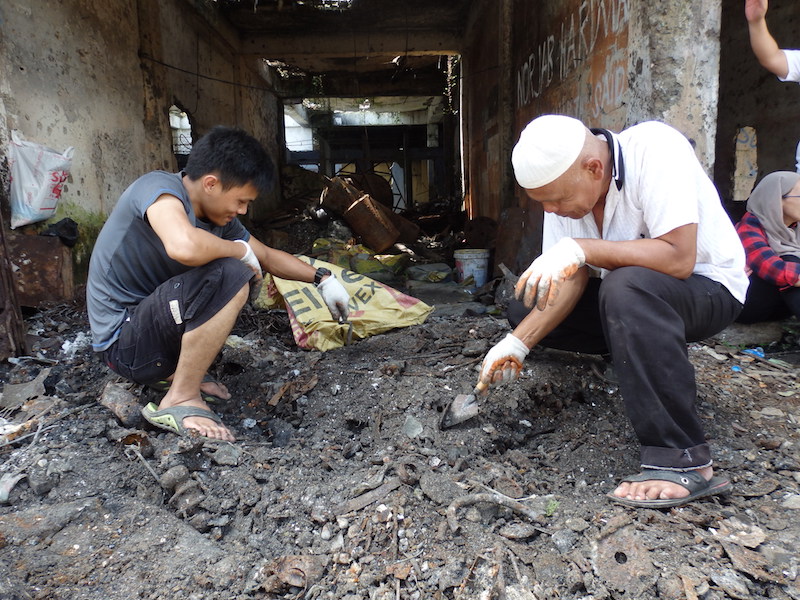 Hadji Said and son Jabar work on the debris at what used to be the entrance to their hardware store along Dangcal Street in Padian on Ma 8, 2018, searching for nothing in particular but whatever item they can find that they can sell to the city’s fast-rising business enterprise: junk shops. MindaNews photo by CAROLYN O. ARGUILLAS
Hadji Said and son Jabar work on the debris at what used to be the entrance to their hardware store along Dangcal Street in Padian on Ma 8, 2018, searching for nothing in particular but whatever item they can find that they can sell to the city’s fast-rising business enterprise: junk shops. MindaNews photo by CAROLYN O. ARGUILLAS
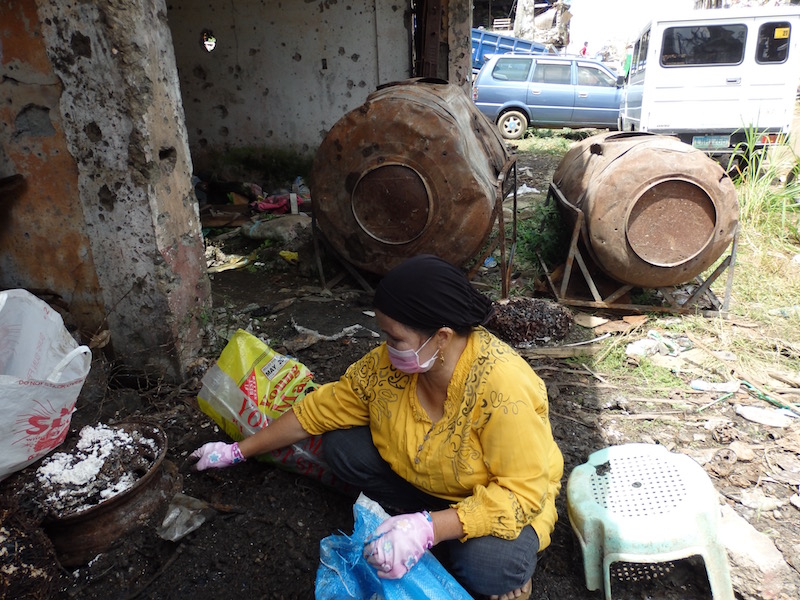 The burnt water tanks behind Hadji Saidah Macaronsing, 51, would have sold for 15,000 and 11,000 pesos if brand new but would now fetch only around 150 pesos at the junk shop. MIndaNews photo by CAROLYN O. ARGUILLAS
The burnt water tanks behind Hadji Saidah Macaronsing, 51, would have sold for 15,000 and 11,000 pesos if brand new but would now fetch only around 150 pesos at the junk shop. MIndaNews photo by CAROLYN O. ARGUILLAS
They also retrieved two water tanks worth 15,000 and 11,000 pesos if brand new, that he estimates would be worth only around 150 pesos at most at the junk shop.
Other storeowners interviewed by MindaNews — or more accurately, former storeowners in what used to be the city’s commercial district — said the price of junk had gone down to seven pesos per kilo, citing the law of supply and demand.
It is higher by three to four pesos per kilo in Iligan City but trucking cost is expensive they might as well settle for less here.
Jabar and his neighbors were forced to close shop mid-afternoon of Tuesday, May 23, 2017 when around 40 young men clad in black, aged between 15 and 18, arrived at the commercial district brandishing their firearms and their black Islamic State (IS) flags.
Like his neighbors and the rest of Marawi’s 210,000 residents, Jabar thought it would be over by sundown or in a day or two.
But it would take nearly a year before Jabar’s family, other residents and storeowners in the 24 barangays in Ground Zero, the 250-hectare main battle area (MBA) between government forces and the IS-inspired Maute Group from May 23 to October 23, 2017, could return to their villages under the Kambisita sa MAA” (Visit the Most Affected Area), as the former MBA is now referred to.
Assistant Felix Castro, Field Office Manager of Task Force Bangon Marawi (TFBM), told MindaNews they are still consolidating the reports on Kambisita but as of May 3, a total of 7,799 families or an estimated 57,100 individuals, had visited the area.
Ground Zero was home to at least 27,000 families, 11,163 of whom were home owners while the rest were “sharers and renters,” Castro said.
Kambisita
Kambisita, which ran from April 1 to May 10, divided Ground Zero into nine sectors and gave residents and storeowners three days each, from 6 a.m. to 3 p.m. to collect whatever they can still salvage from the rubble of their homes and shops.
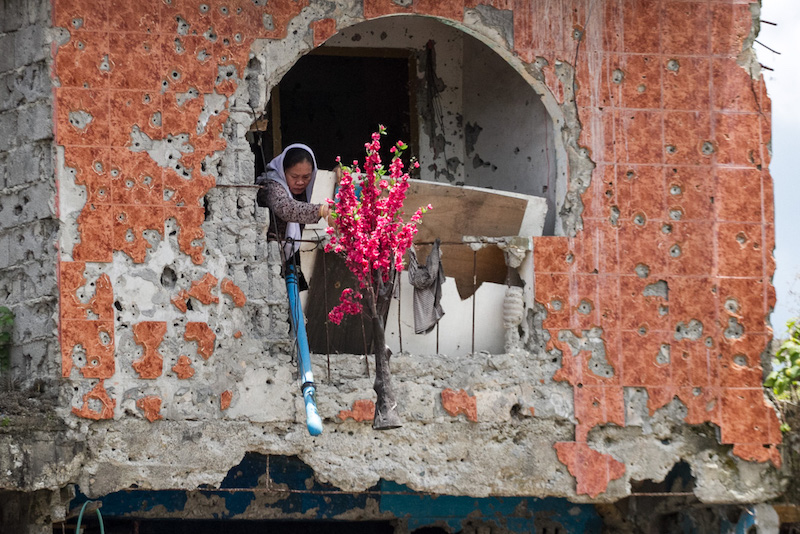 Norhana Panandigan throws out of her third floor balcony a plastic flower decoration during her visit to Marawi City’s Ground Zero on May 8, 2018. MindaNews photo by MANMAN DEJETO
Norhana Panandigan throws out of her third floor balcony a plastic flower decoration during her visit to Marawi City’s Ground Zero on May 8, 2018. MindaNews photo by MANMAN DEJETO
Padian was under Sector 9, the last sector comprising barangays Lumbac Marinaut, Marinaut West, Datu Naga, Dansalan and Datu sa Dansalan, scheduled on May 8, 9 and 10.
Sector 9 was also where the Maute Group’s Omarkhayyam Maute and the Abu Sayyaf’s Isnilon Hapilon, the anointed Emir of the ISIS in Southeast Asia, were killed on October 16, 2017.
A soldier pointed to a vacant lot at the Reclamation Site in Barangay Datu sa Dansalan — what had served as parking space for visiting residents — as the area where the two were killed. There was no trace of the buildings where they made their last stand. Demolished, he explained.
The mosque nearby where the last of the followers of Hapilon and Maute stood their ground, had also been demolished.
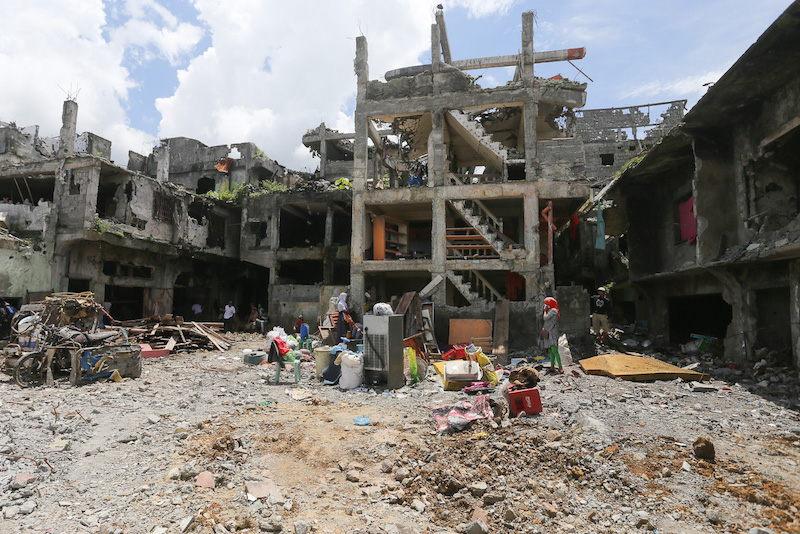 TThe buildings where the Abu Sayyaf’s Isnilon Hapilon and the Maute Group’s Omar Maute made their last stand and where they were killed used to stand on this now vacant lot, a soldier pointed to MindaNews on May 8, 2018. “Demolished,” he said. MindaNews photo by MANMAN DEJETO
TThe buildings where the Abu Sayyaf’s Isnilon Hapilon and the Maute Group’s Omar Maute made their last stand and where they were killed used to stand on this now vacant lot, a soldier pointed to MindaNews on May 8, 2018. “Demolished,” he said. MindaNews photo by MANMAN DEJETO
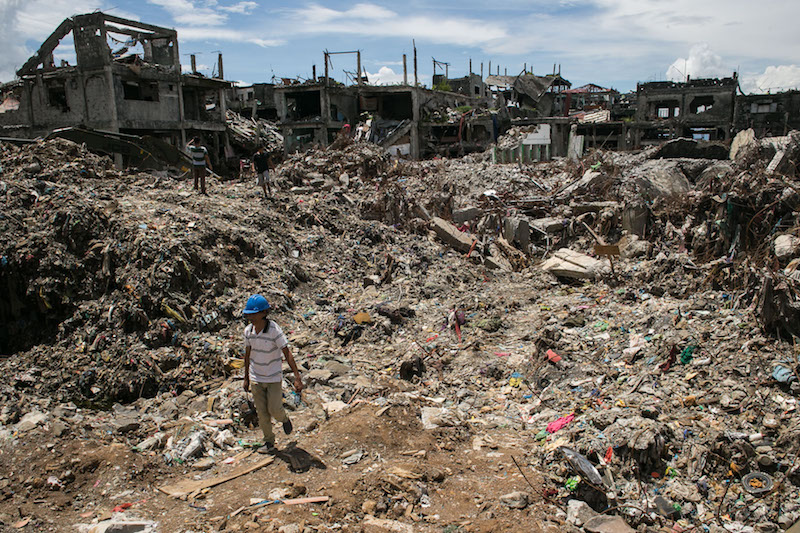 What remains of the mosque where the Maute Group held their last stand in Marawi City’s Ground Zero in October 2017. Photo taken 08 May 2018. MindaNews photo by MANMAN DEJETO
What remains of the mosque where the Maute Group held their last stand in Marawi City’s Ground Zero in October 2017. Photo taken 08 May 2018. MindaNews photo by MANMAN DEJETO
Elsewhere in Sector 9, men and women were busy picking up pieces of their shattered lives — silver trays, some of them bullet-riddled, a set of wooden chairs — or what’s left of them, a wooden door, a refrigerator that may no longer function, a toy car for a two-year old daughter, a deformed bike, a gold-painted teapot, a wet handbag.
Namira Sarimanok’s grocery, located near the mosque in Datu Naga, was not only emptied of its 2.8 million peso worth of stocks, whoever stayed there during the war left behind trash — biscuit and candy wrappers, drank juice from tetra paks and just left them strewn on the floor. Her two-door refrigerator which has to be checked if it is still functioning, she found leaning towards the floor, its contents emptied. She found bullet casings on where eggs are usually stored.
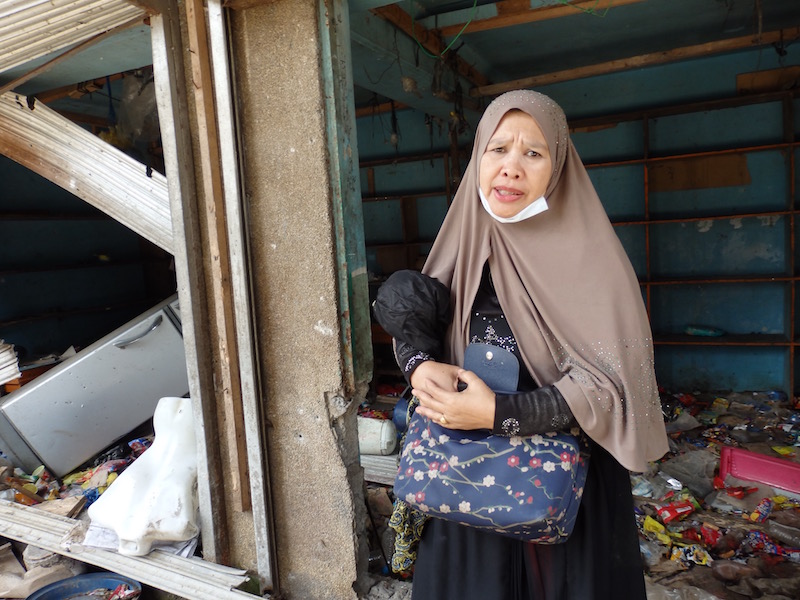 An emptied grocery with trash all over greeted Namira Sarimanok on May 8, 2018 in Msrawi’s Ground Zero. She also found her two-door refrigerator emptied of its contents, but for bullet casings in the section for eggs, left behind by whoever occupied her grocery during the war last year. MIndaNews photo by CAROLYN O. ARGUILLAS
An emptied grocery with trash all over greeted Namira Sarimanok on May 8, 2018 in Msrawi’s Ground Zero. She also found her two-door refrigerator emptied of its contents, but for bullet casings in the section for eggs, left behind by whoever occupied her grocery during the war last year. MIndaNews photo by CAROLYN O. ARGUILLAS
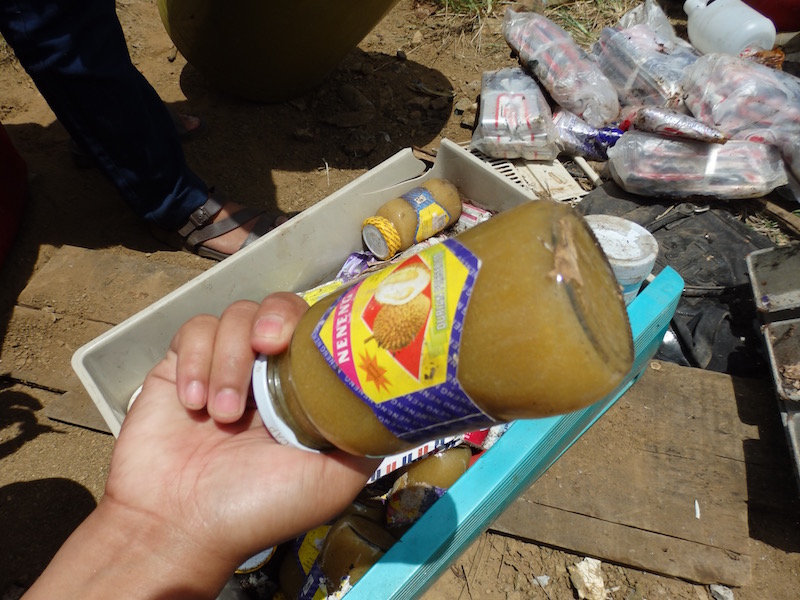 Grocery owners in Marawi City stocked up on bottled durian preserves supposedly intended for iftar – breaking the fast – during the Ramadan. Ramadan was three to four days away when the war broke out on May 23, 2017. MindaNews photo by CAROLYN O. ARGUILLAS
Grocery owners in Marawi City stocked up on bottled durian preserves supposedly intended for iftar – breaking the fast – during the Ramadan. Ramadan was three to four days away when the war broke out on May 23, 2017. MindaNews photo by CAROLYN O. ARGUILLAS
Grocery owners like Namira had a huge inventory when the war broke out because Ramadan was about to start in three to four days.
At least two grocery owners told MindaNews they had an inventory of 200,000 pesos and 700,000 pesos worth of bottled durian preserves, a popular item for the iftar, when people break their fast.
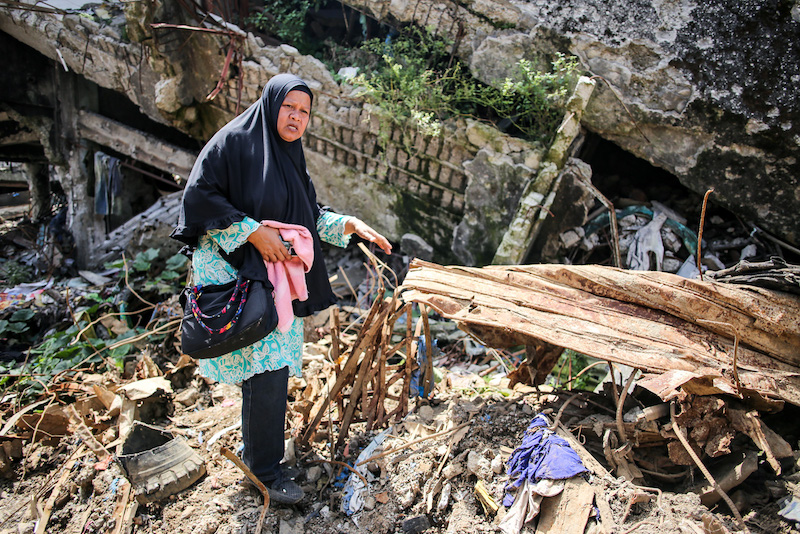 Aisah Manua in front of the ruins of her residence and commercial building along Dangcal Street in Padian, Marawi City on May 8, 2018. Manua rented the ground floor to a relative who used it as a grocery. MindaNews photo by MANMAN DEJETO
Aisah Manua in front of the ruins of her residence and commercial building along Dangcal Street in Padian, Marawi City on May 8, 2018. Manua rented the ground floor to a relative who used it as a grocery. MindaNews photo by MANMAN DEJETO
“Walang natira” (Nothing left) was an oft-repeated response of visiting residents. In most cases, there was no need to ask. The extent of the damage of the buildings was the response itself.
Junk
Vehicles and trucks leaving Ground Zero carried a part of their homes or shops that they could sell at the junk shops — a portion of the gate, window grills. Some brought hacksaws to cut off iron grills.
Along Papandayan St., the exit for those who visited Ground Zero, junk shops and junkyards have sprouted on both sides of the road.
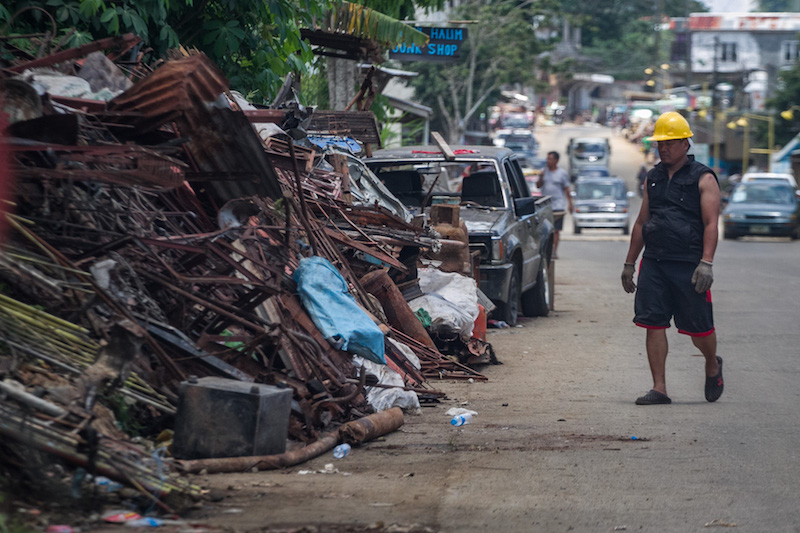 Junk shops on both sides of Papandayan Street in Marawi City. MindaNews photo by MANMAN DEJETO
Junk shops on both sides of Papandayan Street in Marawi City. MindaNews photo by MANMAN DEJETO
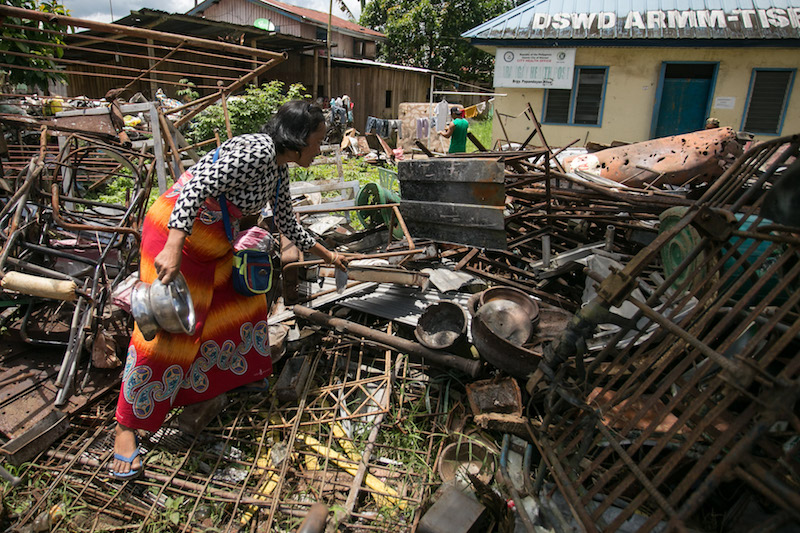 Junk shop owner Nor-Asia checks a pile of scrap metal from inside Ground Zero in Marawi City in a junk shop in Brgy. Papandayan, Marawi Ciy on May 9, 2018. MindaNews photo by MANMAN DEJETO
Junk shop owner Nor-Asia checks a pile of scrap metal from inside Ground Zero in Marawi City in a junk shop in Brgy. Papandayan, Marawi Ciy on May 9, 2018. MindaNews photo by MANMAN DEJETO
Junk shop owner Nor-Asia, who says she has been in this business for 12 years, says the other junk shops opened only when the Kambisita began.
Nor-Asia buys the Ground Zero junk at 7 pesos per kilo for solid metal, 3 pesos for light metal, 35 pesos per kilo for aluminum, 100 per kilo for brass, and 200 pesos per kilo for copper wire.
She sells the junk in Iligan City, some 40 kilometers away, at 10 pesos per kilo for solid metal and six pesos for light metal, and a bigger profit margin for aluminum, brass and copper.
Saving for years, for decades
Majed Rascal whose family’s Norhana Rascal Textile in the Padian has been selling textile for 26 years, laments their losses. “Ilang taon naming pinag-ipunan, ilang dekada…” (We saved up for this for years, for decades), he said.
“Wala ni isang telang naiwan. Wala namang bakas ng sunog” (Not a single cloth was left behind. Yet there is no trace of fire), Rascal wondered.
The store selling rice and other merchandise owned by Hedjarah Alip Bacarat 71, was even older, at 43 years when the war broke out last year. What was once a store made of wood in 1964 had, over the years, evolved into the three-door Bacarat Building 2. A few meters away, at the opposite corner, stood Bacarat Building 1, where they lived until the war forced them to leave on May 24 and seek refuge in their relatives’ homes in Cagayan de Oro City.
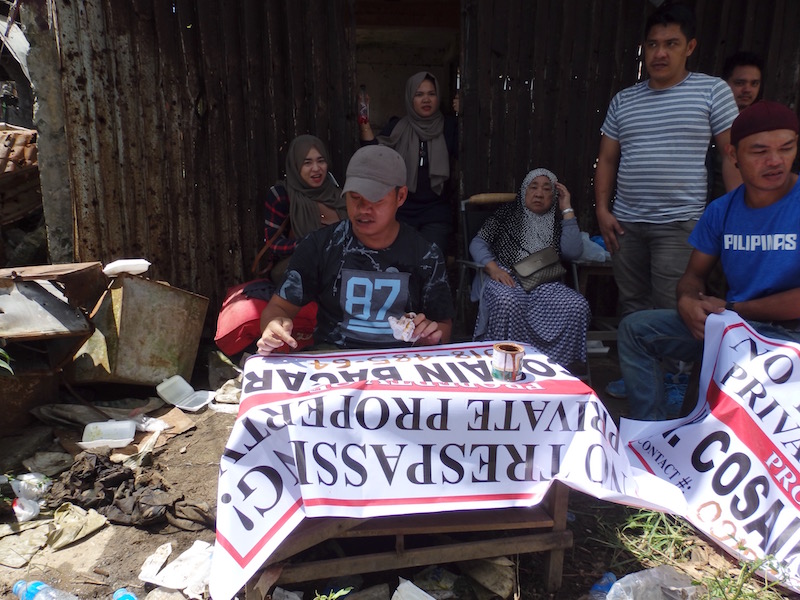 Hedjarah Alip Bacarat 71 (seated) traveled all the way from Cagayan de Oro where she evacuated to escape the war last year, to see for herself what has happened to her residential and commercial buildings, both located int Padian in Marawi City. The store made of wood in 1964 had since evolved into a three-door building. MindaNews photo by CAROLYN O. ARGUILLAS
Hedjarah Alip Bacarat 71 (seated) traveled all the way from Cagayan de Oro where she evacuated to escape the war last year, to see for herself what has happened to her residential and commercial buildings, both located int Padian in Marawi City. The store made of wood in 1964 had since evolved into a three-door building. MindaNews photo by CAROLYN O. ARGUILLAS
Bacarat, mother of 15, insisted on coming to Marawi, even if on wheelchair, to see what happened. “Gusto talaga niyang masilayan yung pinaghirapan niya kahit wasak na ito. Masakit dahil lahat ng hanapbuhay namin, nawala sa isang iglap” (She really wanted to see what has happened to what they had worked hard for, even if they’re gone. It’s painful because Bacarat buildings 1 and 2 were gone in an instant), her daughter Jehan Pangcoga said.
Asserting ownership
Aside from salvaging whatever can be salvaged from what used to be their homes, residents and storeowners of Ground Zero were busy putting up makeshift signages on iron sheets, tarpaulin, plywood, scrap wood, on the walls or posts.
On Tuesday, the Bacarats painted on a salvaged iron sheet and installed it on the facade but on Wednesday, a tarpaulin was placed over the iron sheet giving notice to everyone — “No trespassing. Private Property of…”
A number approached MindaNews requesting for photographs of them with their makeshift signages.
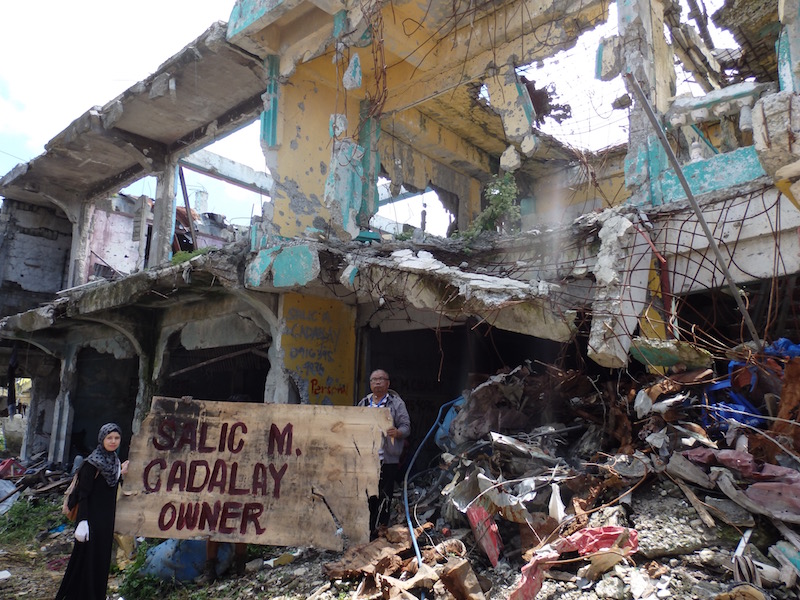 Salic M. Cadalay and his daughter put up makeshift signages on what used to be their hardware storeroom at the Padian in Marawi City. MindaNews photo by CAROLYN O. ARGUILLAS
Salic M. Cadalay and his daughter put up makeshift signages on what used to be their hardware storeroom at the Padian in Marawi City. MindaNews photo by CAROLYN O. ARGUILLAS
The next time they can return to the area to rebuild their homes and stores would be “most likely first quarter 2020,” Housing Secretary Eduardo del Rosario, concurrent TFBM chair said in early April.
Del Rosario told a press briefing in Malacanang last month that their timeline for the debris clearing and site development, which includes the road network and the underground utilities for water, electricity and telecommunications, is “about 18 months” from the groundbreaking in June.
Groundbreaking for the Ground Zero development plan, if the contract is awarded to developers by May 31, will be on June 7, 2018, he said. On May 12, he told MindaNews that groundbreaking will be moved to a date after the Ramadan.
The month-long Ramadan is expected to begin on May 15.
“Isauli namin yan”
In his visit to Marawi on May 11, President Rodrigo Duterte assured Meranaws only Meranaws will benefit from the rehabilitation. “I assure you, walang tao na hindi Meranaw na makinabang dito sa rehab. Isauli namin yan, wala kaming ambisyon dyan” (those who are not Meranaws will not benefit from the rehab. We will return that to you. We don’t aim for anything else).
Duterte asked for “a little time” to rehabilitate.
Addressing the wealthy Meranaws, he said, “linisin lang namin ‘yung bahay” (literally ‘we will clean your house’ but he likely meant clear the debris). He vowed to give priority to the poor Meranaws, adding that housing units would go to those who have been rendered homeless.
He said once the debris is cleared, “isauli namin ‘yan” (we will return the land to whoever owns it),” he said.
Duterte, whose grandmother was a Meranaw, said he will place government lands under land reform. “I will break it up into lands at i-land reform ko, ibigay ko sa inyo” (I will give to you).
“And I will commit to you, as a Meranaw, I will commit to you now na magbuhos ako ng tulong, mga tractor, fertilizer pati seedlings (I will pour help, tractors, fertilizers and seedlings).
At present, there is no enabling law as the Comprehensive Agrarian Reform Program (CARP) had expired and the Comprehensive Agrarian Reform Program Extension with Reforms had also expired on June 30, 2014.
A substantial part of Marawi City is classified as a military reservation, according to a Proclamation issued by the late President Elpidio Quirino in 1953. Meranaws contend they have pre-existing rights as Marawi is their ancestral home.
Del Rosario had earlier told MindaNews Ground Zero does not fall within the military reservation. (Carolyn O. Arguillas / MindaNews)
